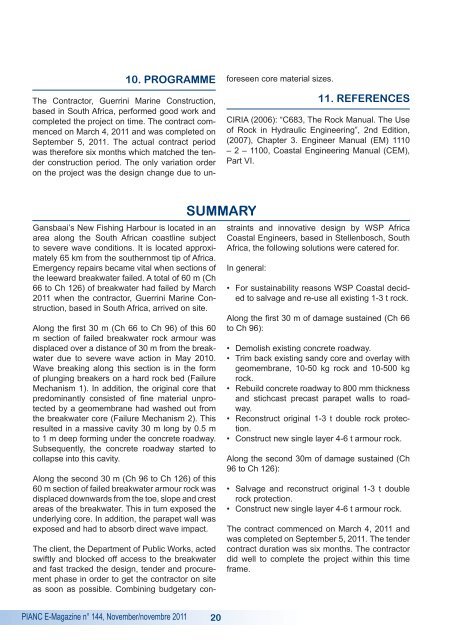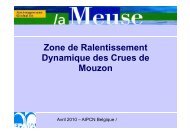PIANC E-Magazine - PIANC AIPCN welcome
PIANC E-Magazine - PIANC AIPCN welcome
PIANC E-Magazine - PIANC AIPCN welcome
You also want an ePaper? Increase the reach of your titles
YUMPU automatically turns print PDFs into web optimized ePapers that Google loves.
10. PROGRAMME<br />
The Contractor, Guerrini Marine Construction,<br />
based in South Africa, performed good work and<br />
completed the project on time. The contract commenced<br />
on March 4, 2011 and was completed on<br />
September 5, 2011. The actual contract period<br />
was therefore six months which matched the tender<br />
construction period. The only variation order<br />
on the project was the design change due to unforeseen<br />
core material sizes.<br />
11. REFERENCES<br />
CIRIA (2006): “C683, The Rock Manual. The Use<br />
of Rock in Hydraulic Engineering”, 2nd Edition,<br />
(2007), Chapter 3. Engineer Manual (EM) 1110<br />
– 2 – 1100, Coastal Engineering Manual (CEM),<br />
Part VI.<br />
Gansbaai’s New Fishing Harbour is located in an<br />
area along the South African coastline subject<br />
to severe wave conditions. It is located approximately<br />
65 km from the southernmost tip of Africa.<br />
Emergency repairs became vital when sections of<br />
the leeward breakwater failed. A total of 60 m (Ch<br />
66 to Ch 126) of breakwater had failed by March<br />
2011 when the contractor, Guerrini Marine Construction,<br />
based in South Africa, arrived on site.<br />
Along the first 30 m (Ch 66 to Ch 96) of this 60<br />
m section of failed breakwater rock armour was<br />
displaced over a distance of 30 m from the breakwater<br />
due to severe wave action in May 2010.<br />
Wave breaking along this section is in the form<br />
of plunging breakers on a hard rock bed (Failure<br />
Mechanism 1). In addition, the original core that<br />
predominantly consisted of fine material unprotected<br />
by a geomembrane had washed out from<br />
the breakwater core (Failure Mechanism 2). This<br />
resulted in a massive cavity 30 m long by 0.5 m<br />
to 1 m deep forming under the concrete roadway.<br />
Subsequently, the concrete roadway started to<br />
collapse into this cavity.<br />
Along the second 30 m (Ch 96 to Ch 126) of this<br />
60 m section of failed breakwater armour rock was<br />
displaced downwards from the toe, slope and crest<br />
areas of the breakwater. This in turn exposed the<br />
underlying core. In addition, the parapet wall was<br />
exposed and had to absorb direct wave impact.<br />
SUMMARY<br />
The client, the Department of Public Works, acted<br />
swiftly and blocked off access to the breakwater<br />
and fast tracked the design, tender and procurement<br />
phase in order to get the contractor on site<br />
as soon as possible. Combining budgetary constraints<br />
and innovative design by WSP Africa<br />
Coastal Engineers, based in Stellenbosch, South<br />
Africa, the following solutions were catered for.<br />
In general:<br />
• For sustainability reasons WSP Coastal decided<br />
to salvage and re-use all existing 1-3 t rock.<br />
Along the first 30 m of damage sustained (Ch 66<br />
to Ch 96):<br />
• Demolish existing concrete roadway.<br />
• Trim back existing sandy core and overlay with<br />
geomembrane, 10-50 kg rock and 10-500 kg<br />
rock.<br />
• Rebuild concrete roadway to 800 mm thickness<br />
and stichcast precast parapet walls to roadway.<br />
• Reconstruct original 1-3 t double rock protection.<br />
• Construct new single layer 4-6 t armour rock.<br />
Along the second 30m of damage sustained (Ch<br />
96 to Ch 126):<br />
• Salvage and reconstruct original 1-3 t double<br />
rock protection.<br />
• Construct new single layer 4-6 t armour rock.<br />
The contract commenced on March 4, 2011 and<br />
was completed on September 5, 2011. The tender<br />
contract duration was six months. The contractor<br />
did well to complete the project within this time<br />
frame.<br />
<strong>PIANC</strong> E-<strong>Magazine</strong> n° 144, November/novembre 2011 20




